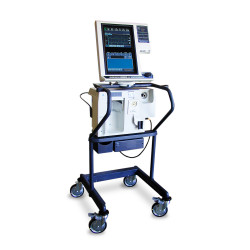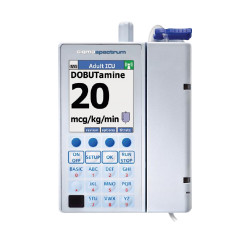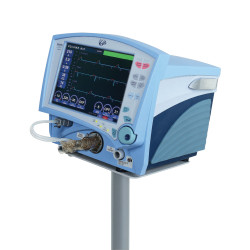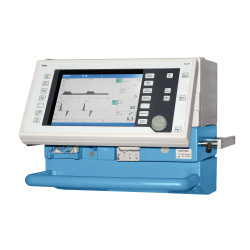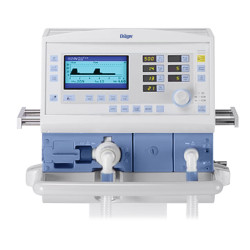Philips Respironics V60 Ventilator



Philips Respironics V60 Ventilator
0 item is in your cart. View cart now
All product and company names are trademarks of their respective holders. Use of them does not imply any affiliation with or endorsement or sponsorship by them.
Details
Taking NIV Further
The Respironics V60 Ventilator combines Respironics' ventilation expertise with Philips' focus on simplifying advanced health care. The result is the noninvasive ventilation gold standard with an invasive ventilation safety net and an interactive display that helps simplify patient management.
The Respironics V60 uses Auto-Trak technology to help ensure patient synchrony and therapy acceptance. Auto-Trak technology is designed to address the specific challenges of NIV. By providing auto-adaptive leak compensation, inspiratory triggering, and expiratory cycling, Auto-Trak delivers optimal synchrony in the face of dynamic leak and changing patient demand.
The success of NIV often depends on the speed and ease of treatment initiation. The V60 supports this critical step in NIV with an expansive color touchscreen and pre-defined settings for Respironics hospital masks. You select the setting, and the V60 automatically calibrates flow characteristics for better monitoring and therapy.
- The Respironics V60 also helps you take NIV further by meeting the needs of a broader patient population. Designed to include pediatric use and equipped with several modes, the V60 allows you to meet the specific needs of individual patients.
- AVAPS maintains a target tidal volume in a pressure limited mode. It provides extra assurance similar to a volume limited mode with the safety of a pressure limited mode.
- CPAP with C-Flex offers three levels of flow-based expiratory pressure relief. This option leads to improved sleep quality and patient comfort, adding greater flexibility and improved treatment acceptance.
- PCV can be used when greater control of the patient's breathing pattern is required. Additionally, the option of ventilating a patient invasively gives the caregiver greater flexibility in the approach to treatment.
- PPV (proportional pressure ventilation) delivers pressure and flow in proportion to the patient's effort, enabling the patient to more efficiently adjust their breathing to meet their changing requirements. Proportional assist modes have been shown to lower peak pressures as compared to pressure support and may improve patient comfort.1 Patient comfort leads to therapy compliance, which may improve the success of noninvasive ventilation.
- Auto-Trak Plus, an optional software option available in the S/T, PC, AVAPS, and PPV modes, is for the subset of patients who may benefit with a customized titration of triggering and cycling criteria. In certain patients with extremely weak efforts or in others with low compliance, Auto-Trak Plus lets clinicians make finely-tuned adjustments to the base Auto-Trak algorithm to achieve patient-ventilator synchrony.
The Respironics V60 has additional advantages:
- High resolution graphics facilitating waveform interpretation.
- Internal 6-hour battery enables intra-hospital transport (actual battery time will vary depending on user settings and battery charge level).
- Standby mode supports patient-clinician interaction without nuisance alarms.
- Data communication capabilities support hospital connectivity.
- Respi-Link, a remote communication tool, allows efficient system diagnostics and upgrades via internet.
Specifications
Patient Types
- Adult: ≥ 20 kg
- Pediatric: ≥ 20 kg
Modes
- CPAP - Continuous positive airway pressure
- S/T - Spontaneous with timed backup
- PCV - Pressure control ventilation
- AVAPS - Average volume assured pressure support (optional)
- PPV - Proportional pressure ventilation (optional)
Settings
- C-Flex: Off, 1 to 3
- CPAP: 4 to 25 cm H2O
- EPAP: 4 to 25 cm H2O
- IPAP: 4 to 40 cm H2O
- I-time (inspiratory time): 0.30 to 3.00 sec
- Max P (AVAPS maximum IPAP): 6 to 40 cm H2O
- Min P (AVAPS minimum IPAP): 5 to 30 cm H2O
- O2 (oxygen percent): 21 to 100%
- Ramp Time: Off, 5 to 45 min
- Rate (respiratory rate): 4 to 60 BPM
- Rise (rise time): 1 to 5
- Triggering and cycling: Auto-adaptive (Auto-Trak) or Auto-Trak Plus (optional) Trigger = normal, +1 to +7, Cycle = -2, -1, normal, +1 to +6
- AVAPS target tidal volume: 200 to 2000 ml BTPS
- Max E: 0 to 100 cmH2O/l
- Max R: 0 to 50 cmH2O/l/s
- PPV%: 0 to 100%
- Max P (PPV maximum pressure limit): 5 to 40 cmH2O
- Max V (PPV maximum volume limit): 200 to 3500 ml
Patient Data
- Breath phase/trigger indicator: Spont, Timed, Exhale
- PIP: 0 to 50 cm H2O
- Patient/total leak: 0 to 200 l/min BTPS
- Patient Trigger: 0 to 100%
- Respiratory Rate: 0 to 90 BPM
- Ti/Ttot: 0 to 91%
- Minute volume: 0 to 99.0 l/min BTPS
- Tidal volume: 0 to 3000 ml BTPS
General
- Oxygen inlet pressure range: 276 to 600 kPa (40 to 87 psig)
- Weight with optional battery: 10.9 kg (24 lb)
- Weight without optional battery: 10.0 kg (22 lb)
Dimensions
- Height: 33.7 cm (13.3 in)
- Width: 39.4 cm (15.5 in)
- Depth: 42.9 cm (16.5 in)
Electrical
- AC voltage: 100 to 240 VAC
- AC frequency: 50 to 60 Hz
- AC power: 300 VA
- Battery operating time: 6 hours in normal conditions
